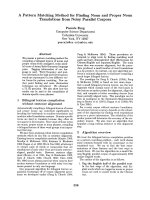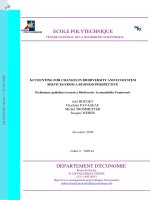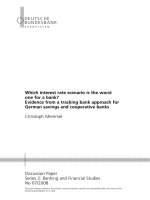Process for producing propylene and ethylene from a light hydrocarbon stream comprising essentially ethane and butane
Bạn đang xem bản rút gọn của tài liệu. Xem và tải ngay bản đầy đủ của tài liệu tại đây (20.16 KB, 3 trang )
Process for producing propylene and ethylene from a light hydrocarbon stream comprising
essentially ethane and butane.
The process involves a non-catalytic cracking of ethane and normal- butane followed by a metathesis
of ethylene and 2-butene to increase the propylene yield.
Optionally the by-produced iso-butane is dehydrogenated and subsequently the produced iso-butene
is converted to other valuable products like di-isobutylene, alkylate for gasoline blending, tertiarybutyl-ethers, polyisobutylene, methyl-metacrylate or isoprene.
Olefins have long been desired as feedstocks for the petrochemical industries. Olefins such as
ethylene, propylene and butenes are useful in preparing a wide variety of petrochemicals, including,
but not limited to, polymers and methyl-tertiary-butyl-ether.
Gas field heavier hydrocarbons consist generally of ethane, propane, butanes and liquid condensate.
The butanes consist of both normal-butane and iso-butane. It is much easier to separate iso-butane
from normal-butane than separating iso-butene from a mixture of hydrocarbons having 4 carbons.
It is an object to provide a flexible process for the production of ethylene and propylene from
propane produces high amounts of ethylene .
a light hydrocarbon feedstock comprising essentially ethane, propane and butane is fractionated to
obtain a C3 fraction used as LPG, an ethane fraction and a butane fraction. The butane fraction is sent
to the cracking zone through the de-isobutanizer, the ethane fraction is sent to the cracking zone.
Fig 1 is a process flow scheme illustrating .
Upstream of the cracking furnace, the butane mixture is fractionated into a rich iso- butane cut at the
overhead and a rich normal-butane cut at the bottom of the distillation column.
The non-catalytic cracking of normal-butane results in low iso-butene make. The cracked products
are compressed up to about 30-35 bar.
The number of compressor stages depends on the refrigerant and its corresponding temperature that
is used for condensing the overhead of columns that separate the light hydrocarbons and hydrogen
from the heavier hydrocarbons.
The raw C4 fraction, produced as the overhead of the de-butaniser column is selectively
hydrogenated to convert the dienes and alkynes into butenes.
This stream is mixed with ethylene and converted over a metathesis catalyst to produce propylene.
The product of the metathesis reactor is fractionated in a de-propaniser.
The overhead product is cooled down to create a reflux stream.
Part of the condensed reflux stream can be pumped to the inlet of the de-ethaniser of the steam
cracker complex. The light olefin vent stream (C2 vent recycle) can flow to the inlet of the fourth stage
compressor of the steam cracker complex that is typically at a pressure of 8 to 12 bars.
a raw butane stream comprising iso and normal-butane is sent via line 1 to a de-isobutanizer 10.
The rich normal-butane cut effluent is sent via line 11 to the normal-butane cracking furnace 15.
An ethane fraction is sent via line 2 to the ethane cracking furnace 16.
The cracked products are sent via lines 21 and 22 to the quench tower 23 and subsequently to the
compressors 31-35, then through driers 36 to the de-methanizer 40.
The lights are sent via line 41 to the PSA 42 (pressure swing adsorption) to separate methane and
hydrogen.
The bottoms of the de- methanizer 40 are sent via line 43 to the de-ethanizer 50.
The overhead of de-ethanizer 50, a mixture essentially of ethylene and ethane, is sent via line 51
through an acetylene converter 52 to a C2-splitter 60.
Ethylene is recovered via line 61 and ethane is recycled via line 62 to the ethane cracking furnace 16.
A part of the ethylene produced is sent via line 63 to the metathesis reactor 100.
Bottoms of the de-ethanizer 50 are sent via line 53 to a catalytic de-propanizer 70 in which MAPD
(methyl acetylene and propadiene) and at least a part of the dienes and alkynes having four or more
carbons are substantially hydrogenated into the corresponding olefins.
Overhead of de-propanizer 70 is sent via line 71 to a C3-splitter 85 to recover propylene on top and
propane at the bottom.
Propane can be either recycled to the steam cracking furnace or sold to the LPG market.
The bottoms of the catalytic de-propanizer 70 are sent via line 72 to the de-butanizer 80.
The raw C4 fraction, produced as the overhead of the de-butaniser column 80 is sent via line 81 to a
hydrogenation section 90-95 to be selectively hydrogenated to convert the remaining dienes and
alkynes into butenes.
After the first selective hydrogenation reactor 90, part of the reactor effluent can be recycled through
line 91 to control the inlet concentration of dienes and alkynes.
The remaining effluent of reactor 90 flows through line 93 to the finishing selective hydrogenation
reactor 94.
The effluent of reactor 94 is sent via line 95 and mixed with ethylene of line 63 to enter the
metathesis reactor 100 to produce propylene.
The metathesis section can contain optionally pretreated to remove possible contaminants in the feed
to the metathesis reactor.
The product of the metathesis reactor is fractionated in a de-propaniser 110.
The overhead product 111 is cooled down to create a reflux stream 112.
Part of the condensed reflux stream can be pumped and sent via line 113 to the inlet of the deethaniser 50 of the steam cracker complex.
The light olefin vent stream (C2 vent recycle) can flow via line 114 to the inlet of the fourth stage
compressor of the steam cracker complex.
The bottoms of the de-propanizer 110 are sent via line 115, as well as heavies from the de-butanizer
80, via line 82 to a full hydrogenation unit 120 and then recycled via line 121 to the normal-butane
cracking furnace, optionally through the de-isobutanizer 10.
In table 1 are the cracking products of various hydrocarbons from a steam cracker









